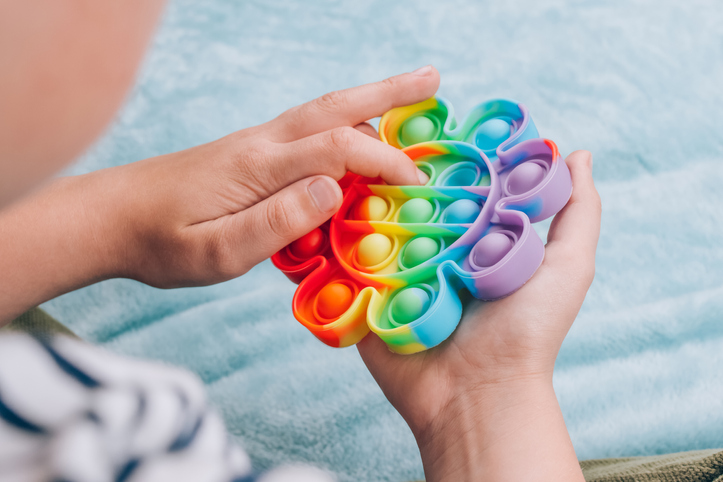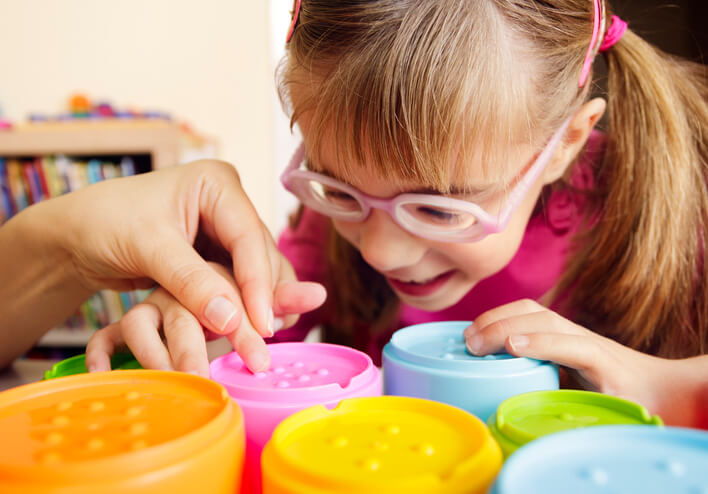As we continue the exploration of sensory processing during OT month, we dive into the specifics of Tactile sensory processing. In case you missed the first part of this series, be sure to read up on What is Sensory Processing?
What is Tactile Processing?
Tactile processing is often referred to as your sense of touch. It is the way your body perceives and responds to input on the outermost system of your body: your skin and the nerves and muscles underneath. Response to vibration, temperature, pain, and pressure are all involved in this complex system. A child might be either over-responsive or under-responsive to tactile sensory input, though sometimes can display signs of both. For this reason, tactile processing does not just refer to what your child is actually touching with their hands, but also how they might react to even the thought of interacting with tactile input.
Over-responsive
Children who are over-responsive to tactile touch may show signs like avoiding messy play, struggling wearing socks or shoes, have difficulty with hair washing. They might also disliking giving or receiving hugs, as well as tolerating holding hands during transitions. Over-responsiveness means that your child has a heightened response to tactile input, and might respond negatively, or even emotionally, to being touched or the thought of being touched.
Under-responsive
When a child is under-responsive, they may seek out tactile input in a variety of ways. You may notice them touching others or objects frequently. They might struggling with grading force (how much or little pressure to use) when grabbing objects, hugging or petting animals. Under-responsive kiddos might not notice messiness on their face or body.
There are a number of strategies you may consider trying with your child to help their body work toward a more typical response to tactile input. It’s important to develop your toolbox of strategies, because what works for them one day, might not work the next. Having options that you can present to your child when they are feeling over or under stimulated and allowing them to choose their strategies teaches them to be independent with their coping mechanisms. Which in turn, helps you, as a parent or caregiver, better understand their needs and preferences.

Strategies for Over-responsive
- Use deep touch before light touch (i.e. pressure squeezes on the scalp before hair brushing, using more pressure during bathing or applying lotions)
- Encourage exploration of different textures while creating a supportive environment – interacting with messy textures with tools like Q-tips if not yet tolerated on hands
- Keeping a wet towel available during meals or messy play and allowing children to clean their hands as needed
- Wilbarger protocol with joint compressions
- Removing tags from clothing and choosing softer textures for fabrics on clothing/blankets/towels
- Model and encourage deep breathing to keep the body in a more calm state
Strategies for Under-responsive
- Incorporate, organized, heavy work and sensory motor based activities throughout the day (climbing, jumping, swinging, running)
- Weight bearing exercises such as animal crawls, yoga, or rolling over a therapy ball
- Hug with deep pressure or offer weighted blankets/lap pads
- Handheld fidgets may support participation in seated activities
- Compression clothing for a consistent tight squeeze
It is important to note that your child may exhibit signs of both over and under-responsiveness to any of their senses. Occupational therapists look for trends and patterns of behavior that are then used to help categorize your child’s sensory responses more appropriately. This allows OT’s to establish a treatment plan and create a set of recommendations that will work best for your child’s sensory difficulties.
Stay tuned for our next blog article which will be discussing Visual sensory processing.
MeBe Occupational Therapy Services
To learn more about Sensory Processing, watch the recorded MeBe Learning Webinar, All About Sensory Processing.
If you’re ready to learn more about Occupational Therapy, Applied Behavior Analysis, Speech and Language Pathology or Feeding Therapy services at MeBe, contact us today.
For helpful tips from the MeBe therapy team, check out @mebefamily on Instagram and Facebook and visit the MeBe Family YouTube channel.

